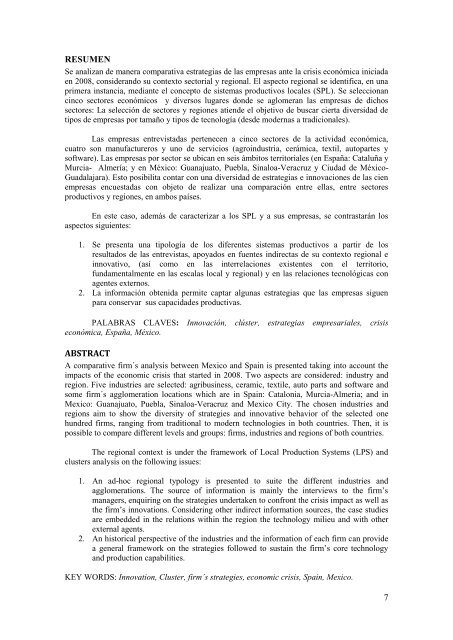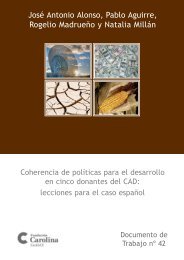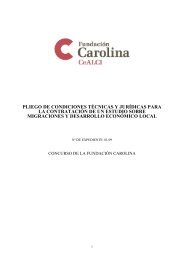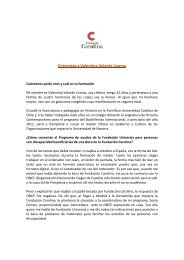Sistemas productivos locales en México y España, sus estrategias ...
Sistemas productivos locales en México y España, sus estrategias ...
Sistemas productivos locales en México y España, sus estrategias ...
You also want an ePaper? Increase the reach of your titles
YUMPU automatically turns print PDFs into web optimized ePapers that Google loves.
RESUMEN<br />
Se analizan de manera comparativa <strong>estrategias</strong> de las empresas ante la crisis económica iniciada<br />
<strong>en</strong> 2008, considerando su contexto sectorial y regional. El aspecto regional se id<strong>en</strong>tifica, <strong>en</strong> una<br />
primera instancia, mediante el concepto de sistemas <strong>productivos</strong> <strong>locales</strong> (SPL). Se seleccionan<br />
cinco sectores económicos y diversos lugares donde se aglomeran las empresas de dichos<br />
sectores: La selección de sectores y regiones ati<strong>en</strong>de el objetivo de buscar cierta diversidad de<br />
tipos de empresas por tamaño y tipos de tecnología (desde modernas a tradicionales).<br />
Las empresas <strong>en</strong>trevistadas pert<strong>en</strong>ec<strong>en</strong> a cinco sectores de la actividad económica,<br />
cuatro son manufactureros y uno de servicios (agroindustria, cerámica, textil, autopartes y<br />
software). Las empresas por sector se ubican <strong>en</strong> seis ámbitos territoriales (<strong>en</strong> <strong>España</strong>: Cataluña y<br />
Murcia- Almería; y <strong>en</strong> <strong>México</strong>: Guanajuato, Puebla, Sinaloa-Veracruz y Ciudad de <strong>México</strong>-<br />
Guadalajara). Esto posibilita contar con una diversidad de <strong>estrategias</strong> e innovaciones de las ci<strong>en</strong><br />
empresas <strong>en</strong>cuestadas con objeto de realizar una comparación <strong>en</strong>tre ellas, <strong>en</strong>tre sectores<br />
<strong>productivos</strong> y regiones, <strong>en</strong> ambos países.<br />
En este caso, además de caracterizar a los SPL y a <strong>sus</strong> empresas, se contrastarán los<br />
aspectos sigui<strong>en</strong>tes:<br />
1. Se pres<strong>en</strong>ta una tipología de los difer<strong>en</strong>tes sistemas <strong>productivos</strong> a partir de los<br />
resultados de las <strong>en</strong>trevistas, apoyados <strong>en</strong> fu<strong>en</strong>tes indirectas de su contexto regional e<br />
innovativo, (así como <strong>en</strong> las interrelaciones exist<strong>en</strong>tes con el territorio,<br />
fundam<strong>en</strong>talm<strong>en</strong>te <strong>en</strong> las escalas local y regional) y <strong>en</strong> las relaciones tecnológicas con<br />
ag<strong>en</strong>tes externos.<br />
2. La información obt<strong>en</strong>ida permite captar algunas <strong>estrategias</strong> que las empresas sigu<strong>en</strong><br />
para conservar <strong>sus</strong> capacidades productivas.<br />
PALABRAS CLAVES: Innovación, clúster, <strong>estrategias</strong> empresariales, crisis<br />
económica, <strong>España</strong>, <strong>México</strong>.<br />
ABSTRACT<br />
A comparative firm´s analysis betwe<strong>en</strong> Mexico and Spain is pres<strong>en</strong>ted taking into account the<br />
impacts of the economic crisis that started in 2008. Two aspects are considered: industry and<br />
region. Five industries are selected: agribusiness, ceramic, textile, auto parts and software and<br />
some firm´s agglomeration locations which are in Spain: Catalonia, Murcia-Almeria; and in<br />
Mexico: Guanajuato, Puebla, Sinaloa-Veracruz and Mexico City. The chos<strong>en</strong> industries and<br />
regions aim to show the diversity of strategies and innovative behavior of the selected one<br />
hundred firms, ranging from traditional to modern technologies in both countries. Th<strong>en</strong>, it is<br />
possible to compare differ<strong>en</strong>t levels and groups: firms, industries and regions of both countries.<br />
The regional context is under the framework of Local Production Systems (LPS) and<br />
clusters analysis on the following issues:<br />
1. An ad-hoc regional typology is pres<strong>en</strong>ted to suite the differ<strong>en</strong>t industries and<br />
agglomerations. The source of information is mainly the interviews to the firm’s<br />
managers, <strong>en</strong>quiring on the strategies undertak<strong>en</strong> to confront the crisis impact as well as<br />
the firm’s innovations. Considering other indirect information sources, the case studies<br />
are embedded in the relations within the region the technology milieu and with other<br />
external ag<strong>en</strong>ts.<br />
2. An historical perspective of the industries and the information of each firm can provide<br />
a g<strong>en</strong>eral framework on the strategies followed to <strong>sus</strong>tain the firm’s core technology<br />
and production capabilities.<br />
KEY WORDS: Innovation, Cluster, firm´s strategies, economic crisis, Spain, Mexico.<br />
7












